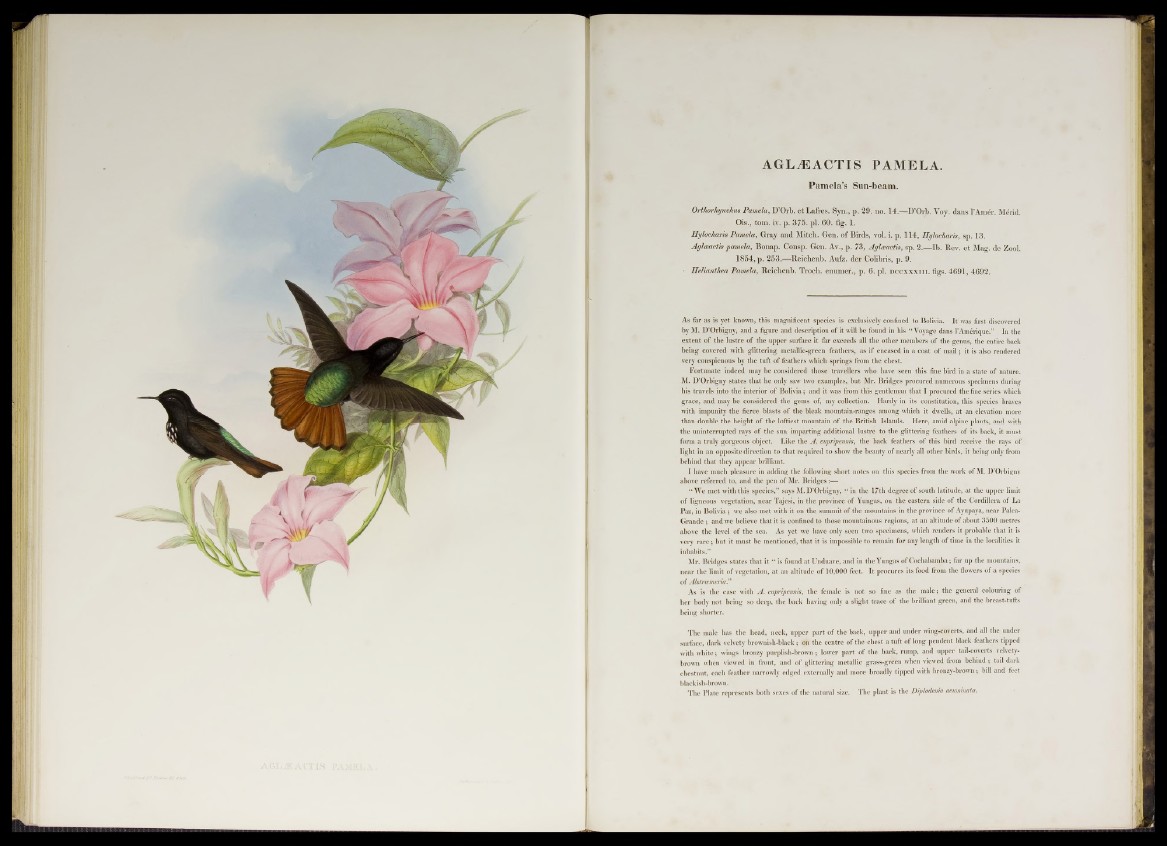
AGLiEACTIS PAMELA.
Pamela’s Sun-beam.
Orthorhynchus Pamela, D’Orb. et Lafres. Syn., p. 29. no. 14.—D’Orl). Voy. dans l’Am^r. Mlrid.
Ois., tom. iv. p. 375. pi. 60. fig. 1.
Hylochari8 Pamela, Gray and Mitch. Gen. of Birds, vol. i. p. 114, Hylochai'is, sp. 13.
Aglaactis pamela, Bonap. Consp. Gen. Av., p. 73, Aglceactis, sp. 2.—lb. Rev. et Mag. de Zool.
1854, p. 253.—Reichenb. Aufz. der Colibris, p. 9.
Helianthea Pamela, Reichenb. Troch. enumer., p. 6. pi. d c c x x x i i i . fig s . 4691, 4692.
As far as is yet known, this magnificent species is exclusively confined to Bolivia. It was first discovered
by M. D’Orhigny, and a figure and description of it will be found in his “ Voyage dans l’Amerique.” In the
extent of the lustre of the upper surface it far exceeds all the other members of the genus, the entire back
being covered with glittering metallic-green feathers, as if encased in a coat of mail; it is also rendered
very conspicuous by the tuft of feathers which springs from the chest.
Fortunate indeed may be considered those travellers who have seen this fine bird in a state of nature.
M. D’Orbigny states that he only saw two examples, but Mr. Bridges procured numerous specimens during
his travels into the interior of Bolivia; and it was from this gentleman that I procured the fine series which
grace, and may be considered the gems of, my collection. Hardy in its constitution, this species braves
with impunity the fierce blasts of the bleak mountain-ranges among which it dwells, at an elevation more
than double the height of the loftiest mountain of the British Islands. Here, amid alpine plants, and with
the uninterrupted rays of the sun imparting additional lustre to the glittering feathers of its back, it must
form a truly gorgeous object. Like the A . cupripennis, the back feathers of this bird receive the rays of
light in an opposite direction to that required to show the beauty of nearly all other birds, it being only from
behind that they appear brilliant.
I have much pleasure in adding the following short notes on this species from the work of M. D’Orbigny
above referred to, and the pen of Mr. Bridges:—
“ We met with this species,” says M. D’Orbigny, “ in the 17th degree of south latitude, at the upper limit
of ligneous vegetation, near Tajesi, in the province of Yungas, on the eastern side of the Cordillera of La
Paz, in Bolivia; we also met with it on the summit of the mountains in the province of Ayupaya, near Palca-
Grande ; and we believe that it is confined to those mountainous regions, at an altitude of about 3500 metres
above the level of the sea. As yet we have only seen two specimens, which renders it probable that it is
very rare; but it must be mentioned, that it is impossible to remain for any length of time in the localities it
inhabits.”
Mr. Bridges states that it “ is found at Unduave, and in the Yungas of Cochabamba; far up the mountains,
near the limit of vegetation, at an altitude of 10,000 feet. It procures its food from the flowers of a species
of Alstrcemeria.”
As is the case with A. cupripennis, the female is not so fine as the male; the general colouring of
her body not being so deep, the back having only a slight trace of the brilliant green, and the breast-tufts
being shorter.
The male has the head, neck, upper part of the back, upper and under wing-coverts, and all the under
surface, dark velvety brownish-black; on the centre of the chest a tuft of long pendent black feathers tipped
with white; wings bronzy purplish-brown; lower part of the back, rump, and upper tail-coverts velvety-
brown when viewed in front, and of glittering metallic grass-green when viewed from behind; tail dark
chestnut, each feather narrowly edged externally and more broadly tipped with bronzy-brown ; bill and feet
blackish-brown.
The Plate represents both sexes of the natural size. The plant is the Dipladenia acuminata.